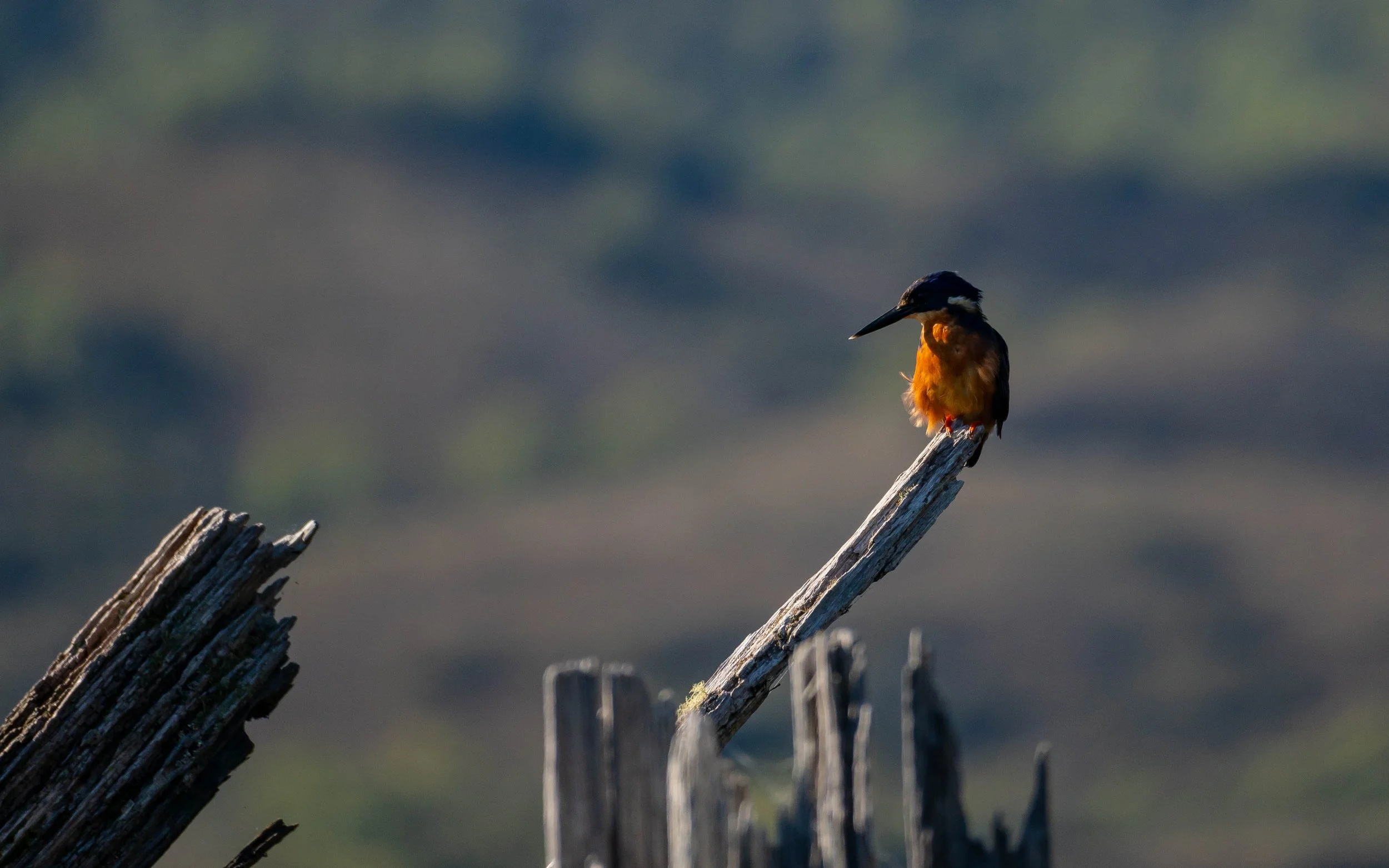Tasmania / Lutruwita
On a misty afternoon this wombat emerges from its burrow to forage for food along the tussocks.
Ronny Creek, Cradle mountain
The most southern state of Australia and almost a country of its own, completely cut off from the mainland, Tasmania. It has been the one state that I had not yet visited in Australia and have been waiting to find the right time to finally cross the Bass strait. After a big move back to Australia from New Zealand we found ourselves with some extra time due to unforeseen circumstances. We decided that it was finally time to head to Tasmania - locally known as Lutruwita. After purchasing a new car (almost our new home), we packed it with our belongings and made our way south. Early one morning we boarded the 9 hour ferry, the Sprit of Tasmania and arrived in Devonport.
As we are both avid wildlife watchers, it was of course on top of our list to to see all the wildlife the island has to offer - which is a lot! First time visiting it took a while to figure out where to go and how to go about it. We started off with finding some platypus as Tasmania is one of (if not the) best place in the country to see them. It is certainly one of my favourite Australian animals and we were very successful in finding several amazing places to view them. They inhabit clean fresh water ways and are mainly nocturnal. This being said we had most of our sightings in the middle of the day when the sun was high in the sky. It seemed like anywhere we looked there was a platypus in the river. Some of my favourite spots to view them are:
Tasmania arboretum - they live in Founders lake
Fern glade - a short walk along Emu river
Mount field National Park - Tyenna river
After a successful time platypus watching we decided to stick to the north western side to start off with. We made our way into some of the national parks and reserves. It did not take long before we encountered our first scorpion, copperhead snake and the beloved echidna.
After some heavy rain during our first days and after getting mudded out at our camp ground, we got really lucky with the weather and had very little rain for the rest of our journey. We made our way to the Tarkine region which is the more untouched part of the island and not too many people venture this way, perfect! This is where we spotted our first wombat at the Manuka campground and the next day we caught a quick glimpse of our only Tasmanian devil for this trip. We will have to come back for more! Everywhere we stayed we were surrounded by pademelons and wallabies.
One of the most popular places to visit is of course Cradle Mountain. A National park only a short drive from Devonport with easy access. We definitely prefer the more quiet and less crowded areas but this place is popular for a reason. Access to the park is limited and during daytime you can only access it by a shuttle bus, this is a great way to reduce traffic and keep animals safer on the roads. Ronny creek is one of the best places in Australia to see wombats. As the afternoon comes around these animals emerge from their burrows to feed. It is important to remember that these animals are still wild and should be respected as such, never try to touch one! Apart from seeing countless wombats we saw echidnas, wallabies, pademelons, possums and even found a platypus in the Pencil Pine creek along the enchanted walk close to the lodge.
One of the highlights from this trip was traveling to Gordon river area and Strahan. We got to catch up with a good friend and her family and cruised along the Gordon river and stayed on their boat on the river overnight. What an amazing way to explore this area! If you want to explore this area yourself, make sure to head on over to Southwest expeditions where you will be great taken care of and have the most amazing experience! There is so much to explore there, such as Sarah island which was used as an old penal settlement where the convicts worked under extremely harsh conditions. We were often followed by common dolphins, had eagles soaring above us and the water lapping against the hull of the boat as we slept.
Being in Tasmania in the winter we were hoping to catch a glimpse of the southern lights, aurora australis, once again Tasmania did not disappoint! After extensive research on cloud coverage on the day that the aurora was supposed to be very strong and finding a place which faces south without mountains and clouds in the way, we ended up at the Pedder wilderness lodge overlooking lake Pedder. We stayed up late that night observing the most beautiful night sky. If you want to see the southern lights for yourself, it can be a bit of a challenge but there are several helpful tools to make your experience better. Make sure you follow a page or download an app where you can get updates of the predicted KP number for your best chances of seeing the aurora. For the Southern Hemisphere, the further south you are and the least amount of light pollution you have in the sky, the better your chances are. For the Northern Hemisphere, you want to be as far north as possible in an area with little cloud coverage and little light pollution.
After spending the night watching the aurora we made our way back to one of favourite national parks in Tasmania, Mount Field. Here we went for walks at night where we spotted several eastern quolls and barred bandicoots. What an experience! Lets not forget about the monotremes, the echidna and the platypus. I noticed that a day was always better in the company of a monotreme! We saw several tiger snakes in the area of lake St Clair, so we have now seen 2 out three species of snake that can be encountered in Tasmania!
After a great time on the west coast it was time to make our way over to the east to continue our journey. We met up with long lost friends in Hobart and had a great time catching up. We made our way over to Bruny island to explore this part of the coast. There is a huge population of albino wallabies living here, the highest concentration of them can be found around Adventure bay, but you could encounter them at any place around the island.
Albino Bennett’s wallaby
One of the albino wallabies we spotted on Bruny Island. This one was seen around Adventure bay.
The evenings were spent at the Neck where you can observe short-tailed shearwaters arriving late at night. They crash land loudly on land after a day feeding out at sea. They return to feed their chicks and once the chicks have grown they all take off around April/May to spend their time out at sea. There is also a small population of little blue penguins here but we failed to see any of them. Each night there were eastern quolls all around the island which was great to see. Even encountered a long-nosed potoroo late one night, who hung out at our campsite!
Wombat grazing as the sun sets
Maria Island
One of the highlights from the trip was spending two nights over on Maria Island. This is a beautiful island where many native animals have been released to help the population grow in the wild. It is home to Tasmanian devils but these animals are extremely shy and we did not see any. What we did see were countless wombats who roam the island, even in the middle of the day. A big population of forester (eastern) kangaroos can be seen on the hills of the western side. We also managed to encounter our third and final snake species in Tasmania, the white-lipped whipsnake! What a treat! There is a great population of Cape Barren geese on the island which can be rare to encounter around the country.
The next week was spent exploring the rest of the east coast, we made our way to Freycinet National Park where we explored Wineglass bay, went for a freedive and enjoyed the beautiful beaches. There are stunning beaches all the way up the coast and it was no problem finding great places to camp. We then made a stop in Binalong bay which is the start of the Bay of fires which has these stunning bright orange lichen on the rocks. This bright orange makes a beautiful contrast with the clear blue waters.
We just made time to visit Mount William National Park which is a beautiful park at the top of the east coast. The beaches are of course stunning and it is full of wildlife. We saw plenty of wombats, wallabies and even saw a massive pod of dolphins off the coastline. Definitely worth a stop if you are in that area!
Bay of fires
Our final destination was to be Narawntapu National Park, a tiny park nestled up on the northern coast only a short distance away from Devonport. We stopped in here as we first made our way over to Tasmania and decided to come back if we had more time. We made time for it and observed the kangaroos, wallabies and the pademelons out on the big plains of the park. Beautiful bird species and one last tiger snake. During the days we saw lots of signs of the tasmanian devil, prints in the mud and also scat. Next time we head over, I am sure we will see more of this elusive animal!

















































